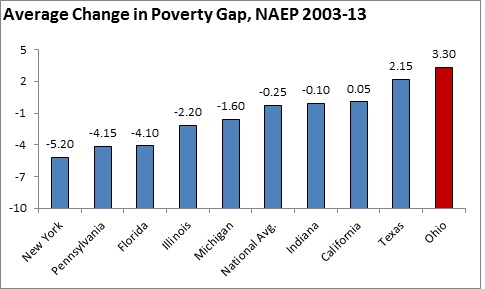Ohio’s Quality Counts Rating – Poverty Gap Change
In Monday’s post, we examined the achievement gains Ohio has made on the NAEP exams from 2003 to 2013. Needless to say, Ohio’s gains were not all that impressive. In this post, I look at how Ohio fares along the “poverty-gap closing” measure used in EdWeek’s Quality Counts report. (This metric is the difference in NAEP achievement between low- and high-income students—and how that gap has changed over time.) The achievement gap between poor and well-off children is substantial across the entire nation, Ohio included, and thus minimizing the differences in achievement levels is a worthwhile policy objective (preferably, by lifting the achievement of poor students, not through reductions in wealthy-students’ performance). The chart below displays the “poverty gap” trend in Ohio, along with several other states: four other Midwestern states, the four most-populous states, and the national average. Among these states, Ohio had the largest increase in the achievement gap; its gap grew 3.3 points from 2003 to 2013. The state also ranked near the bottom nationally on this indicator—38th in the nation, taken as an average of its math and reading ranks. Meanwhile, New York was the U.S. leader in achievement-gap closing during this time period, shearing off 5.2 points in its gap between low- and high-income students. Ohio has a growing achievement gap between its poor and wealthy students, and in fact, one of the worst achievement-gap trends in the nation.

Source: Education Week, Quality Counts. Note: This chart displays each state’s decrease in achievement gaps between poor and wealthy students (negative values) or its increase (positive values) on national tests. I average the gap reduction (or growth) across 4th grade reading and 8th grade math NAEP scores (the test results used by EdWeek).
